We have a curious attitude to wildlife, being very selective about which species we like and which we don't. Often there seems to be no logic regarding which species are considered cute and which vermin.
Rabbits and grey squirrels seem to have a foot or two in each camp, whilst some animals move from one to the other.
For example toads and bats, which used to be disliked and even feared, are now thought endearing and worthy of conservation.
Deer may be moving the opposite way in the public's affections. Once only occasionally glimpsed disappearing into the depths of a forest they are now often encountered.
And not only in the open countryside or places like Cannock Chase; as I have previously reported red deer turn up from time to time in the heart of the Black Country, in and around the Sandwell Valley and areas of Walsall.
People and deer meet more often now because deer numbers are increasing at the same time as there are more visits than ever before to places like Cannock Chase and other open spaces.
Walking, cycling, jogging and horse-riding have never been more popular. This means that deer are spreading to new areas, becoming used to people and therefore less wary of them, and they are more frequently disturbed in their day time resting places.
Recently the annual count of deer on the Chase took place. Organised by the Forestry Commission and Staffordshire County Council, it revealed that the 26 square miles of the Chase is now home to record numbers of deer, probably, despite the cold winter a thousand or more.
In the main part of the Chase they are mainly fallow deer, whilst the larger red deer are concentrated in the south east and are often seen around Burntwood and Brownhills.
More widely, following their 2011 census, the British Deer Society reports that there may be nearly two million deer in Britain and says that in 'urban environments ... there is a serious problem developing with growing deer populations in areas where practical management is very difficult.' ( Full details )
'Practical management' includes culling. Generally between 20 and 30 per cent of the population may be culled each year, but recently there have been calls for this to be increased to 50 per cent. Other problems include illegal poaching, damage to crops, woodlands and gardens, and traffic accidents.
Last year about 160 incidents involving deer and traffic were reported in Staffordshire. In a collision between a deer and a car both the deer and the car's occupants can come off very badly.
Deer may still have the 'aah....' factor, but for how much longer?




















